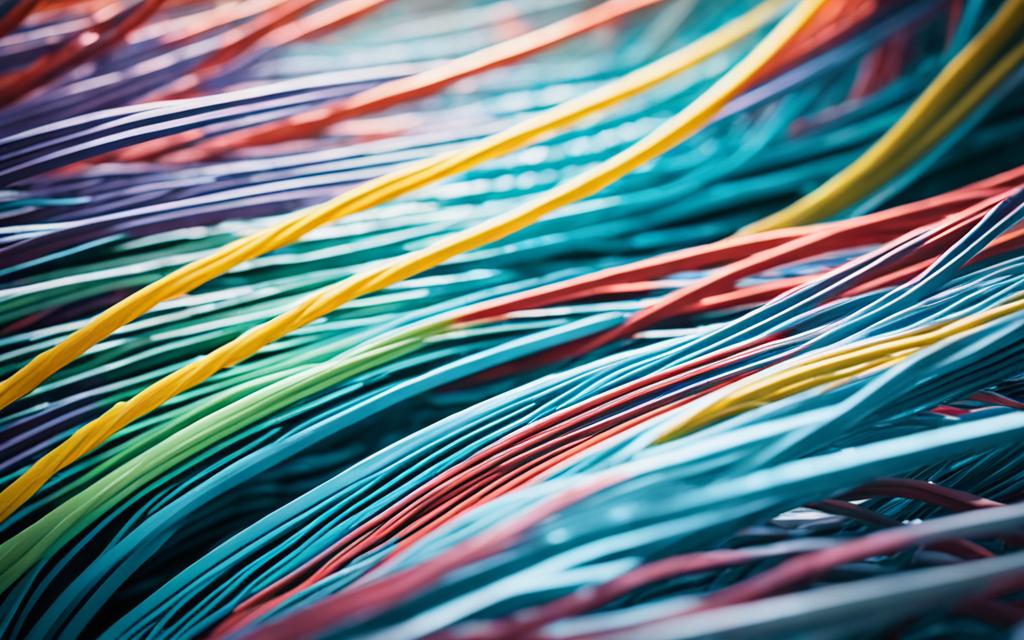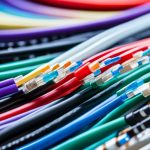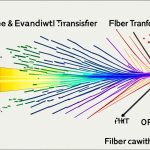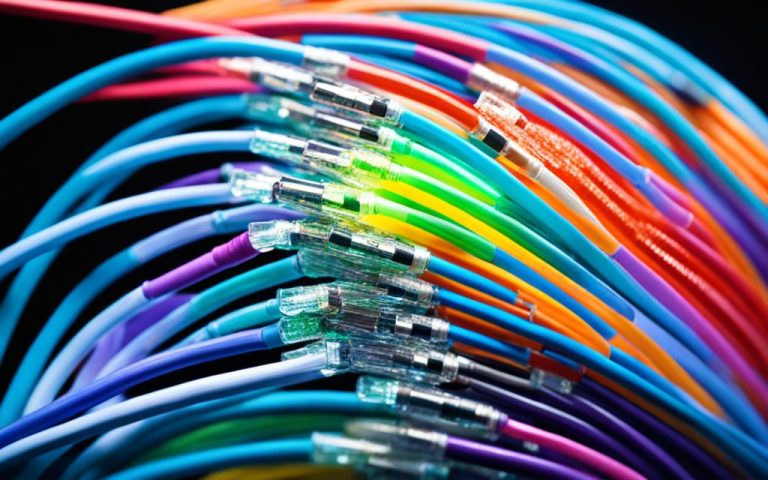Fiber optic technology has revolutionized advancements in fiber optic networks, offering numerous benefits such as faster transmission speeds, enhanced durability, and improved reliability. Recent innovations in fiber optic technology have propelled the industry forward, paving the way for exciting breakthroughs in fiber optic transmission.
From advancements in transmission speeds to high-density fiber optic cables and connectors, these innovations have transformed the way we communicate, connect, and share information. The future has never looked brighter for the world of fiber optics.
But what exactly are these groundbreaking innovations, and how are they reshaping the fiber optic technology landscape? Dive into this article as we explore the latest advancements, their applications, and their potential impact on various industries.
The Basics of Fiber Optics and Its Invention
Fiber optic transmission is made possible through the principles of optical fibers and various components such as cables, connectors, and transceivers. These components work together to enable the efficient transfer of data and signals using light waves.
There are two primary types of fiber optic cables: single-mode and multimode. Single-mode fiber optic cables are designed for long-distance transmission with a single beam of light, allowing for higher bandwidth and low attenuation. On the other hand, multimode fiber optic cables are used for shorter distances and can transmit multiple beams of light simultaneously, making them suitable for applications such as local area networks.
In order to understand the invention of fiber optics, we must acknowledge the contributions of scientists such as Charles Kao, Robert Maurer, Donald Keck, and Peter Schultz.
“We found that glass fibers can be used for transmitting light signals over long distances, which was a groundbreaking discovery for fiber optics.” – Charles Kao
Charles Kao, the “Father of Fiber Optics,” demonstrated the potential of using glass fibers for long-distance transmission of light signals. His pioneering work in the 1960s laid the foundation for fiber optic technology.
Robert Maurer, Donald Keck, and Peter Schultz built upon Kao’s findings and developed the first practical optical fiber at Corning Glass Works in 1970. The team utilized a fused silica core and cladding layer to create a robust and efficient medium for transmitting light signals.
Their collaborative efforts revolutionized the field of fiber optics and paved the way for the widespread adoption of fiber optic communication technology.
Today, fiber optic technology forms the backbone of modern communication networks, providing high-speed data transmission, improved reliability, and scalability. The invention of fiber optics continues to impact various industries, from telecommunications to healthcare, powering the digital transformation across the globe.
Recent Innovations in Fiber Optic Technology
Ongoing research in the field of fiber optic technology has led to significant advancements in various aspects of fiber optic networks. These innovations are driven by the need for faster data transmission speeds, increased bandwidth capacity, and improved reliability. In this section, we will explore some of the recent breakthroughs that have propelled fiber optic technology to new heights.
Advancements in Fiber Optic Transmission Speeds
Fiber optic transmission speeds have witnessed remarkable improvements in recent years. This has been made possible through the development of techniques such as wavelength division multiplexing (WDM) and coherent detection. WDM allows multiple signals to be transmitted simultaneously through a single fiber by utilizing different wavelengths of light. This enables a significant increase in data capacity, leading to faster and more efficient communication.

High-Density Fiber Optic Cables
To meet the growing demand for higher bandwidth and scalability, high-density fiber optic cables have emerged as a key innovation. These cables are designed to accommodate a larger number of fibers within a smaller physical space, enabling efficient space utilization and seamless network infrastructure expansion. The use of high-density cables has revolutionized data centers, telecommunication networks, and other applications that require extensive data transmission capabilities.
Enhanced Durability and Reliability
Enhancing the durability and reliability of fiber optic networks has been a major focus of recent research and development efforts. Fiber optic cables are now manufactured with materials and construction techniques that improve resistance to environmental factors, reducing the risk of signal degradation. Furthermore, improved fault tolerance mechanisms have been implemented to ensure uninterrupted communication even in the event of cable damage or failure.
“The continuous advancements in fiber optic transmission speeds, high-density fiber optic cables, and enhanced durability and reliability features have transformed the capabilities of fiber optic networks, enabling faster communication and greater data capacity.”
| Advancement | Impact |
|---|---|
| Wavelength Division Multiplexing (WDM) | Significantly increased data capacity |
| Coherent Detection Techniques | Improved signal quality and reliability |
| High-Density Fiber Optic Cables | Efficient space utilization and scalability |
| Enhanced Durability and Reliability Features | Reduced risk of signal degradation and improved fault tolerance |
These recent innovations have propelled fiber optic technology to new heights, offering faster transmission speeds, higher bandwidth capacity, and enhanced reliability. They have revolutionized the way data is transmitted and have paved the way for the seamless integration of fiber optics into various industries and applications.
Fiber Optic Technology in Data Centers and Broadband Networks
Fiber optic technology plays a crucial role in data centers, enabling high-speed connectivity and efficient communication between servers, storage systems, and networking equipment. With its ability to transmit data at incredible speeds over long distances, fiber optic links have become the backbone of modern data center infrastructure.
In data centers, optical networking technologies such as dense wavelength division multiplexing (DWDM) and optical switches optimize connectivity, enhancing capacity and flexibility. DWDM allows multiple signals to be transmitted simultaneously over a single fiber optic cable, maximizing bandwidth utilization. Optical switches facilitate efficient routing and switching of data traffic, ensuring seamless communication between different network components.
Furthermore, fiber optic networks have revolutionized broadband connectivity. Fiber-to-the-home (FTTH) deployments have become increasingly popular, offering symmetrical upload and download speeds, low latency, and virtually unlimited bandwidth. This enables the delivery of gigabit and multi-gigabit broadband services, providing users with lightning-fast internet speeds for bandwidth-intensive applications and data-intensive activities.

One of the key advantages of fiber optic technology in data centers and broadband networks is its ability to handle large amounts of data with minimal signal loss. Unlike traditional copper-based cables, fiber optic cables have much higher bandwidth capacity and can transmit data over longer distances without degradation.
The use of fiber optic technology also leads to improved network reliability and uptime. Fiber optic cables are not susceptible to electromagnetic interference, making them ideal for environments with high electrical noise, such as data centers and industrial settings. The durability of fiber optic cables also ensures that they can withstand harsh environmental conditions, reducing the risk of service interruptions.
In conclusion, fiber optic technology plays a vital role in data centers and broadband networks, providing high-speed connectivity, increased capacity, and improved reliability. Optical networking technologies like DWDM and FTTH deployments have revolutionized the way data is transmitted and accessed. With the growing demand for gigabit and multi-gigabit broadband services, fiber optic links will continue to be the preferred choice for organizations and individuals seeking fast and reliable internet connectivity.
Conclusion
The future outlook of fiber optic technology is poised for significant growth and development, despite the challenges in fiber optic communication. Overcoming obstacles such as cost and infrastructure, installation complexity, and customer adoption is crucial to unleash the full potential of fiber optics.
Continuous advancements in transmission speeds and the ability to scale the network infrastructure bode well for the future of fiber optic technology. As fiber optics integrates with emerging technologies like 5G and the Internet of Things (IoT), the possibilities for connectivity and communication are boundless.
Fiber optic networks will serve as the backbone of the future communication infrastructure, offering unprecedented speed, reliability, and efficiency. With the ability to transmit vast amounts of data over long distances, fiber optics will enable a connected world, empowering businesses and individuals alike.
FAQ
What are some of the key benefits of fiber optic technology?
Fiber optic technology offers numerous benefits such as faster transmission speeds, enhanced durability, and improved reliability.
What are the recent innovations in fiber optic technology?
Recent innovations in fiber optic technology include advancements in transmission speeds, high-density fiber optic cables and connectors, and improved durability and reliability features.
Who were the key contributors to the invention of fiber optics?
Charles Kao, Robert Maurer, Donald Keck, and Peter Schultz were the key contributors to the invention of fiber optics.
What types of fiber optic cables are commonly used?
Different types of fiber optic cables, including single-mode and multimode, are commonly used for specific applications.
How does fiber optic technology revolutionize data centers and broadband networks?
Fiber optic technology plays a crucial role in data centers for high-speed connectivity and efficient communication, and in broadband networks, it enables symmetrical upload and download speeds, low latency, and unlimited bandwidth.
What are the challenges in fiber optic deployment and maintenance?
Challenges in fiber optic deployment and maintenance include cost and infrastructure, installation complexity, and customer adoption.
What is the future outlook for fiber optic technology?
Despite challenges, the future of fiber optic technology looks promising, with continued advancements and integration with emerging technologies like 5G and the Internet of Things (IoT).



















